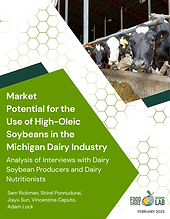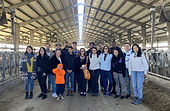High-Oleic Soybean

Vincenzina Caputo

Adam Lock

Sam Rickman

Hattie Polson

An Economic Assessment of the Market Potential for High-Oleic Soybean Feed in Michigan’s Dairy Cattle Market
Motivation. High-oleic soybeans (HOS) promise nutritional, economic, and sustainability benefits for the dairy industry. Research highlights gains in milk fat yield, feed efficiency, and animal health. Yet adoption remains limited, slowed by processing costs, fragmented supply chains, and limited local performance data. These barriers reflect broader challenges in agricultural innovation and coordination across the U.S. food system.
What we do. This study uses individual interviews to gather insights from Michigan soybean farmers, dairy producers, and nutritionists to understand adoption challenges and opportunities. We examine perceptions of financial benefits, supply chain risks, and on-farm performance. Findings inform strategies such as direct contractual partnerships and cooperative processing models aimed at reducing barriers, improving adoption, and supporting more resilient dairy and soybean supply chains.






